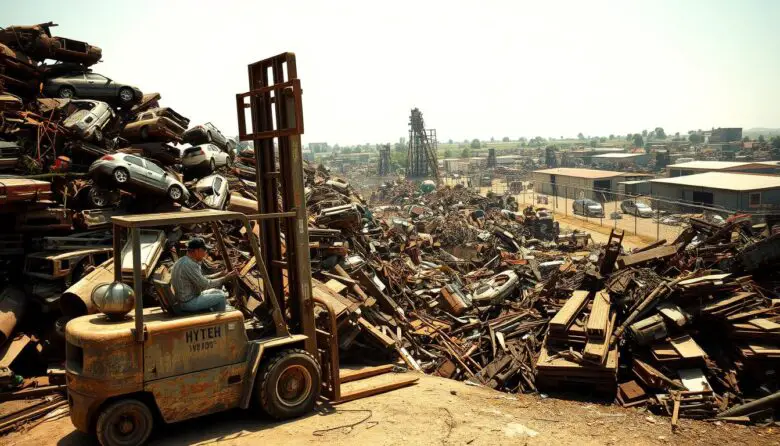Did you know that non-ferrous materials, like copper and aluminum, make up only 10% of recycled scrap but account for 50% of the industry’s revenue? This surprising fact highlights the untapped potential lying in your garage, construction site, or even old appliances. Whether it’s copper tubing or steel from a vehicle, every piece of scrap holds value.
Understanding the types of scrap and their worth is the first step to maximizing your earnings. For example, copper can fetch up to $4 per pound, while aluminum brings in around 55 cents. Knowing how to prepare and sort your materials can make a significant difference in the price you receive at a local scrapyard.
This guide will walk you through the process, from choosing the right vehicle for transport to using equipment like mag cranes and forklifts. You’ll also learn how to negotiate better rates and ensure safety compliance. Ready to turn your scrap into cash? Let’s dive in!
Key Takeaways
- Non-ferrous materials like copper and aluminum are highly valuable in the scrap industry.
- Proper sorting and cleaning of scrap can increase its resale value.
- Understanding market trends helps in negotiating better prices.
- Using the right equipment, such as pickup trucks and cranes, simplifies the process.
- Always call ahead to check current rates at your local scrapyard.
: Understanding the Scrap Metal Market
Recycling scrap metal isn’t just eco-friendly—it’s a lucrative opportunity. The market for these materials is thriving, driven by global demand and sustainable practices. Whether it’s copper from old wiring or steel from construction sites, every piece has value. Understanding how the market works can help you make the most of your efforts.
Why Scrap Metal is a Valuable Commodity
Scrap metal is a valuable resource because it can be recycled indefinitely without losing its properties. Materials like copper and aluminum are in high demand due to their use in industries like construction and renewable energy. For example, recycling aluminum saves up to 95% of the energy needed to produce it from raw materials.
Even obsolete items, like steel shelving, can be repurposed. The quality of the material often determines its value. Clean, sorted scrap fetches higher prices at the local scrapyard. This makes proper preparation essential for maximizing earnings.
Current Market Trends in the United States
The U.S. scrap metal market is influenced by global infrastructure projects and green energy initiatives. Copper, for instance, is essential for electric vehicles and solar panels, driving its price up. Similarly, steel remains a top recycled material, with millions of tons processed annually.
Market rates fluctuate based on supply and demand. Staying informed about these trends can help you time your sales for better profits. For example, prices for aluminum and copper have risen steadily since early 2023, making now a great time to recycle.
Understanding the process—from identifying materials to weighing them at the yard—ensures you get the best rates. With the right knowledge, you can turn your scrap into a profitable venture.
: Preparing Your Scrap for Sale
Turning scrap into cash starts with proper preparation. Knowing how to identify, gather, and sort your materials can make a big difference in the price you receive. Clean, organized scrap is easier to process and often fetches higher rates at the yard.
Identifying Different Types of Scrap Metal
Not all scrap is created equal. Materials like copper, aluminum, and steel have varying market values. For example, copper is highly sought after due to its conductivity, while aluminum is lightweight and recyclable.
Here’s a quick guide to identifying common types:
| Material | Characteristics | Market Value |
|---|---|---|
| Copper | Reddish-brown, non-magnetic | High |
| Aluminum | Lightweight, silver-colored | Moderate |
| Steel | Magnetic, heavy | Low to Moderate |
Gathering and Sorting Your Materials
Once you’ve identified your scrap, the next step is gathering and sorting. Start by separating ferrous (magnetic) and non-ferrous materials. This makes it easier for the yard to process and ensures you get the best price.
Here are some tips for effective sorting:
- Remove contaminants like dirt, grease, or plastic.
- Cut large items into smaller pieces for easier handling.
- Use magnets to distinguish between steel and non-magnetic metals.
Proper sorting not only increases the value of your scrap but also reduces processing time at the scrap yard. Clean, organized materials are weighed more accurately on the scale, ensuring you get fair rates.
: Sell metal: Tips to Maximize Your Profits
Maximizing profits from scrap materials requires a strategic approach. Researching local yards, negotiating effectively, and timing your sale can make a big difference in the value you receive. Let’s explore these steps in detail.
Researching Local Scrap Yards and Recycling Rates
Not all yards offer the same rates for your materials. Start by identifying reputable scrap yards in your area. Call ahead to inquire about current prices for materials like steel and aluminum.
Here’s a comparison of rates at popular yards:
| Yard Name | Steel (per pound) | Aluminum (per pound) |
|---|---|---|
| H&H Metals | $0.15 | $0.60 |
| Green Recycling | $0.12 | $0.55 |
| Eco Scrap | $0.18 | $0.65 |
Comparing rates ensures you get the best deal for your scrap.
Effective Negotiation Strategies
Negotiation is key to maximizing your earnings. Here are some tips:
- Bring clean, sorted materials to show you’re prepared.
- Ask about volume discounts if you have a large load.
- Use customer testimonials or past experiences to build trust.
Being informed about the yard’s weighing process can also help you negotiate better prices.
Timing Your Sale for Better Prices
Market trends influence scrap metal rates. Prices often peak during spring and summer due to increased construction activity. Track these trends to time your sale for maximum profit.
Additionally, consider the yard’s processing times. Selling during less busy hours can ensure faster service and better attention to your load.
By combining research, negotiation, and smart timing, you can turn your scrap into a profitable venture.
: Choosing the Right Vehicle and Equipment
Choosing the right tools and transport can make your scrap recycling journey smoother and more profitable. The vehicle you use and the equipment you bring along play a big role in how efficiently you can handle your materials. Let’s explore the best options for hauling and unloading scrap.
Pickup Trucks vs. Other Vehicles for Transport
When it comes to transporting scrap, pickup trucks are a top choice. Their open bed design makes it easy to load and unload materials quickly. For example, a sturdy truck like the GMC Sierra Denali 2500HD can handle heavy loads without compromising performance.
Other vehicles, like trailers or vans, can also work but may require more effort. Trailers are great for larger quantities, while vans offer protection from weather. However, neither matches the versatility of a pickup truck for most scrap hauling needs.
Essential Equipment for Easy Loading and Unloading
Having the right equipment can save time and effort. A hydraulic crane is a game-changer for lifting heavy items into your truck. Tools like skid steer loaders and forklifts also make the process smoother, especially for bulky materials.
Here’s a quick list of must-have tools:
- Hydraulic crane for heavy lifting
- Skid steer loader for moving large piles
- Forklift for precise placement
Using the right vehicle and equipment not only speeds up the process but also ensures safety. It also helps you get through the scrap yard faster, saving time and increasing your earnings.
: Navigating the Weighing and Processing Procedures
Understanding the weighing process at a scrapyard can significantly impact your earnings. Accurate measurement ensures you receive fair payment for your materials. Let’s break down the steps involved in weighing and processing your scrap.
Understanding the Inbound and Outbound Scale Process
When you arrive at the scrap yard, your vehicle is weighed on the inbound scale. This measures the total weight of your load, including the truck and materials. After unloading, the outbound scale measures the empty vehicle. The difference between these two weights determines the value of your scrap.
Here’s how it works:
| Step | Description |
|---|---|
| Inbound Scale | Weigh your loaded vehicle to get the gross weight. |
| Unloading | Use equipment like cranes or forklifts to remove materials. |
| Outbound Scale | Weigh your empty vehicle to calculate the net weight. |
Always keep the weight ticket provided by the yard. It serves as proof of measurement and ensures transparency in the process.
Exploring the Role of Mag Cranes and Forklifts
Different materials require specific equipment for unloading. Ferrous materials, like steel, are handled using mag cranes. These powerful tools use magnets to lift heavy loads efficiently. Non-ferrous materials, such as aluminum, are often unloaded with forklifts.
- Position your vehicle correctly on the scale to avoid errors.
- Verify the scale readings before and after unloading.
- Ask about the calibration frequency of the scales for accuracy.
By understanding these procedures, you can ensure a fair and efficient transaction. For more tips on managing your materials, check out this guide on starting a profitable home-based business.
: Expert Techniques for Maximizing Scrap Value
Unlocking the full potential of your scrap materials requires expert techniques and insider knowledge. By focusing on high-value alloys and leveraging industry insights, you can significantly boost your earnings. This section dives into actionable strategies to help you get the most out of your efforts.
Leveraging Lucrative Alloys and High-Value Metals
Not all scrap is equal. Materials like brass and copper are highly sought after due to their market value. For example, brass can fetch up to $1-$2 per pound, making it a lucrative option for recyclers. Copper, on the other hand, is prized for its energy-efficient recycling process and consistent demand in industries like construction and renewable energy.
Here’s why these materials stand out:
- Brass: Often found in plumbing fixtures and electrical components, it’s easy to identify and highly recyclable.
- Copper: Known for its conductivity, it’s commonly used in wiring and electronics, ensuring steady market demand.
By focusing on these high-value materials, you can maximize your returns and make the most of your recycling efforts.
Tips from Industry Experts
Industry professionals emphasize the importance of timing and preparation. One expert notes, “Selling during peak construction seasons can lead to higher prices due to increased demand.” Additionally, staying informed about market trends helps you identify the best times to sell.
Here are some expert-backed strategies:
- Sort and clean your materials thoroughly to increase their value.
- Build relationships with local yards to access better rates and insider information.
- Use advanced tools like magnets and sorting bins to streamline the process.
By combining these techniques with a deep understanding of the market, you can turn your scrap into a profitable venture. Stay updated with expert advice and market trends to always work smartly.
: Ensuring Safety and Compliance in the Scrap Yard
Navigating a scrap yard requires awareness of safety and legal protocols. These facilities handle heavy machinery, hazardous materials, and valuable resources, making compliance essential. By understanding the rules and using modern systems, you can protect yourself and maximize your earnings.
Preventing Metal Theft with Modern Systems
Scrap yards have implemented advanced technologies to prevent theft and ensure transparency. Many facilities now use thumbprint registration and database tracking to monitor every transaction. These systems link sellers to the materials they bring in, creating a secure environment.
Electronic signals and monitoring tools track the movement of scrap within the yard. This ensures that all materials are accounted for and reduces the risk of unauthorized removal. By adopting these measures, scrap yards protect both their business and their customers.
Staying Informed on Legal Registration Requirements
Legal compliance is a top priority in the scrap industry. Most states require sellers to provide identification and register their materials. This process ties your identity to the scrap you sell, preventing illegal activities like theft or fraud.
Here’s how to stay compliant:
- Bring a valid ID to the scrap yard for registration.
- Ensure your materials are properly documented and labeled.
- Ask about local laws and regulations to avoid penalties.
Following these steps not only keeps you on the right side of the law but also builds trust with the yard. Compliance ensures a smooth process and protects the value of your materials.
: Conclusion
Turning unused materials into profit is both rewarding and environmentally beneficial. By understanding the market, preparing your materials, and using the right equipment, you can maximize your earnings. Proper sorting and cleaning of items like copper and aluminum ensure higher value at the yard.
Expert tips, such as leveraging high-value alloys and timing your sale, can significantly boost your returns. Always stay informed about market trends and negotiate effectively to get the best price. Safety and compliance are equally important—ensure you follow legal requirements and use modern systems to protect your materials.
With the right approach, recycling becomes a smart and profitable venture. Stay proactive, apply these techniques, and turn your scrap into a valuable resource. Success in this field is both an art and a science when done right.
FAQ
Why is scrap considered a valuable commodity?
Scrap is valuable because it can be recycled and reused in manufacturing, reducing the need for raw materials. Items like copper, aluminum, and steel are in high demand for their versatility and durability.
How can I identify different types of materials for recycling?
Look for specific characteristics like color, weight, and magnetism. For example, copper has a reddish hue, while aluminum is lightweight and non-magnetic. Sorting materials correctly ensures better pricing at the yard.
What’s the best way to research local recycling rates?
Contact nearby yards or check their websites for current pricing. Rates often vary based on market trends, so comparing multiple locations can help you get the best deal.
Should I use a pickup truck for transporting materials?
Pickup trucks are ideal for their versatility and ease of unloading. However, ensure your vehicle can handle the weight and size of your load to avoid damage or safety issues.
What is the inbound scale process at a yard?
The inbound scale process involves weighing your vehicle before unloading. This helps determine the exact weight of your materials, ensuring accurate pricing based on the scale’s measurements.
How can I maximize the value of my materials?
Focus on high-value items like copper, brass, and certain alloys. Separating materials and cleaning them can also increase their worth, as yards often pay more for sorted and prepared loads.
How can I prevent theft of my materials?
Use secure storage systems, such as locked garages or fenced areas. Additionally, consider registering your materials to help track them in case of theft.
What equipment is essential for loading and unloading?
Tools like mag cranes, forklifts, and sturdy gloves make the process easier and safer. Having the right equipment ensures efficient handling of heavy or bulky items.
When is the best time to sell for better prices?
Prices often fluctuate based on market demand. Keep an eye on trends and consider selling when rates for materials like steel or aluminum are high.
Are there legal requirements for selling materials?
Yes, some areas require registration or proof of ownership to prevent theft. Always check local regulations to ensure compliance and avoid potential issues.















Leave a Reply